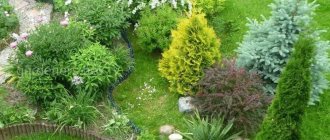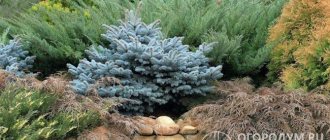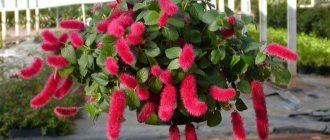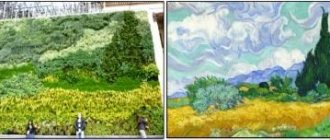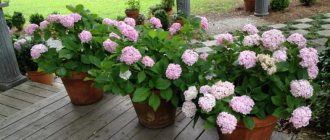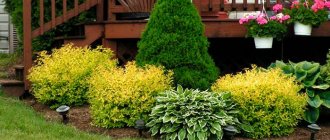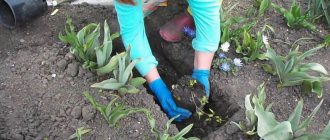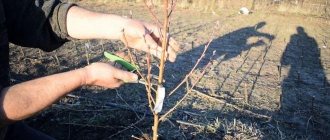The best examples of topiary art can be seen in the famous garden at the Levens Hall estate in England. Lions, chess pieces, peacocks, and geometric compositions made of yew have been growing here for at least three centuries. And they still inspire gardeners to create their own home masterpieces.
- Rules for cutting coniferous plants
- When to trim conifers
- Care before and after haircut
You can create topiary objects of any complexity from coniferous plants. Among the species with plastic, flexible branches - even intricate figures of animals and people, letters and numbers. But beginners should not set themselves the goal of turning an overgrown thuja or juniper bush into an unknown animal. First you need to master cutting simple geometric shapes - ball, cube, pyramid, cylinder, cone. And only then start creating spirals, arches, bersaults and other art objects.
Why trim
First of all, you need to clearly understand why pruning coniferous shrubs and trees is required. Gardeners usually produce it to:
- contain growth;
- emphasize the appearance;
- give an unusual shape - cube, pyramid, cone, ball, etc. (decorative haircut);
- thicken the crown;
- reduce the distance between shoots;
- remove diseased, broken, dry branches;
- create a garden sculpture (topiary cutting).
The need for the procedure is determined by the gardener himself.
Kinds
Forced (therapeutic)
It is carried out unscheduled when the plant has been attacked by insects or has become infected with a fungus. In such cases, it is necessary to remove the damaged parts as quickly as possible so that the infection does not spread to the rest. Therefore, the owner of the site should always have gardening tools at the ready. However, this is not only a life-saving, but at the same time a traumatic procedure. Therefore, the wound (the cut site) will need to be treated for some time - treated with garden varnish.
Planned (sanitary, preventive)
It is part of the basic care of coniferous trees and shrubs. Each species and variety has its own pruning dates. Some tolerate it better in the spring, some in the fall. The main tasks are to remove dead wood, prevent diseases, strengthen the immune system, inhibit growth and give a well-groomed appearance.
Formative (decorative)
It is carried out to form a crown, the silhouette of which is thought out in advance. Requires constant work with conifers throughout the season, from early spring to late autumn. A popular type of pruning among gardeners who want to create unique images on their site. Requires special skill and experience.
Topiary (shrub sculpture, topiary)
Topiary pruning of conifers, so popular today, is a separate type of gardening art within the framework of landscape design. This is no longer just a shaping, but a curly haircut to give plants more complex silhouettes than geometric images. For example, animals, people, interior items, etc.
Shrub sculpture requires a lot of effort, time and attention. The most complex figures have to be leveled almost daily. Here we should take into account the fact that purely coniferous plants (whose needles are hard and rough) are among the most difficult for topiary art. They are too freedom-loving and inflexible to be forced to grow along the intended trajectory. Therefore, it is much easier to create a garden sculpture to take conifers with scaly flat leaves - thuja, juniper or cypress. Their soft branches are much easier to correct.
Most often, spiral cutting of thuja is used in topiary. It is quite easy to do using thread markings and looks chic. Photo:
Garden bonsai is usually formed from Cossack juniper:
When
One of the most pressing questions of all gardeners: when do they prune conifers? This depends mainly on two factors - its purpose and the varietal characteristics of shrubs and trees.
Forced
Therapeutic pruning is carried out at any time of the year, as soon as it is noticed that a shrub or tree has been attacked by insects or is sick. Some pathologies are detected in early spring, immediately after the snow melts. It is important here not to confuse the usual sunburn, which many conifers receive in February-March, and yellowing of the needles as a result of the disease. However, more often fungi and pests begin to be active in May. So you have to be ready at any moment.
Planned
Two dates must be marked in the gardener’s calendar for mandatory sanitary pruning of conifers - in spring and autumn.
- in spring
Firstly, immediately after the thaw, shearing is done in order to remove dead wood that has formed over the winter. During hibernation, almost every plant loses a certain part of its old branches. If they are no more than ⅓ of the crown, there is no need to worry. The branches are simply removed, trimmed and the tips plucked to control growth - and then only monitor growth and development during the warm season.
- in autumn
Pruning in the fall is much more functional, but it is best to do it in November, when the coniferous plant has already fallen asleep for the winter. At this time, biochemical processes are suspended and there is less chance of disrupting them. Although experts constantly argue about this. Some advise cutting in September, before preparations for wintering begin.
Why is autumn pruning of conifers so important?
Firstly, over the summer you can track the degree of growth. If the indicator is too high and this is unacceptable for your area, growth is restrained by cutting.
Secondly, if a tree or shrub is sick, it is known which parts of it can retain the remains of fungal pores or a clutch of pest eggs. Sometimes these are places that are so difficult to reach that it is better to cut off the branch, but you will be sure that in the spring the attack will not overcome the plant again.
Thirdly, this procedure is one of the stages of preparation for hibernation. By removing everything unnecessary, you will ensure an even distribution of nutrients inside the trunk, without losing them to diseased branches.
And, of course, after a high-quality autumn haircut, it will be much easier to do it in the spring, when the crown is almost formed.
Formative
- in spring
If the planned spring pruning turned out to be easy, that is, a negligible number of branches were removed, then parallel formation of conifers is allowed. It is important to do this precisely at this stage, even before the buds open, so that stress for the plant is minimal. By giving the crown the desired silhouette, you will direct its growth in the right direction from the very beginning.
According to landscape designers, shrubs and trees have their own memory. If you cut them for several years according to the same pattern, each time you will remove less and less material. This is explained by the fact that they begin to grow according to a familiar pattern, which they “remember.” If the tree has lost too many branches during spring pruning, it is better to delay shaping for a month.
- In summer
A crown-shaping haircut requires constant trimming throughout the summer. It is produced as needed. Preferably once every 2 weeks. During this time, usually several early ripening branches are knocked out of the silhouette, which should be cut off.
- in autumn
The last shaping is done in late autumn, preferably together with the planned one, in order to send the plant to sleep with a ready-made crown.
Topiary
But for topiary, the timing of pruning is determined individually. Usually, to create figures from conifers, a metal or plastic frame is purchased, which is installed next to the plant in early spring, while it has not yet awakened from hibernation. With its help, a tree or shrub is given the desired shape. And only then, as it grows and develops, pruning, cutting, and pinching are done. In this case, the branches will have to be constantly forcibly directed in the direction in which they should grow according to the plan.
Photo gallery of topiary cutting of conifers:
Framework for creating figures:
Ancient art
The art of utilitarian and artistic plant shaping began thousands of years ago.
According to surviving images and ancient texts, already in the gardens of ancient Greece and Rome, green trimmed walls, voluminous geometric shapes and living, skillful sculptures formed by topiary gardeners from various trees and shrubs, mainly boxwood and cypress, became widespread. After a long medieval cooling of interest in this garden technique during the Renaissance and Baroque, a second wave of interest in haircuts arose in Europe, associated with the development of a regular style and, in its various variations, which has survived to this day.
Tools
What tools are needed:
- pruning shears (bypass, with an anvil, ratchet mechanism, electric scissors);
- brush cutter (with straight and wave-shaped sharpening);
- hacksaw;
- lopper;
- scissors.
Tool selection criteria:
- sharp sharpening;
- a light weight;
- comfortable handle;
- safe operation;
- bright colors for easy searching in the garden;
- narrow ends to allow easier access to the base of branches.
High-quality, constant sharpening of tools is 50% (if not more) of the success of the entire event. Secateurs (scissors, hedge trimmers, etc.) should remove the branch the first time, sharply - this minimizes trauma and stress. After each pruning, it is necessary to disinfect the tool so that there are no pest eggs, fungal spores, or infections left on it, which otherwise would then spread throughout the entire area.
When using any cutting tool, you must take precautions and act strictly according to the instructions.
How to do something yourself, with your own hands - home craftsman website
AN EXCELLENT TOOL FOR CRAFTERS AND HANDCRAFTS AND EVERYTHING FOR THE GARDEN, HOME AND Cottage LITERALLY FOR FREE - SEE FOR YOURSELF. THERE ARE REVIEWS.
How to trim conifers: curly and non-curly haircuts
If you only knew how much we lose in creating the appearance of a coniferous garden by missing the issue of shaping!
We spend money on new varieties without understanding the obvious truth - often they are not so necessary.
The appearance of the plant can be recreated using a hedge trimmer and garden shears.
TOOLS FOR HOME AND GARDEN, HANDCRAFTS, ETC. PRICES VERY LOW
But it’s scary to take it and cut it. What if we kill it?
Rules for cutting conifers
Rule 1. Think twice - cut once
This way you can change the well-known saying. This is the basic rule that should be followed so as not to harm a tree or shrub. A pruner in the hands of even a skilled craftsman is a real instrument of torture for a plant. An incorrectly removed knot causes injury. In this regard, a novice gardener must first:
- study theory;
- watch a video - training master classes on how to properly prune coniferous shrubs and trees;
- start with a planned haircut;
- after its successful development, you can begin to form the crown;
- To make a coniferous topiary on your site with your own hands, it is better to enroll in short-term courses in gardening skills or landscape design.
Knowledge of theoretical fundamentals and practical skills will make pruning a minimally stressful procedure.
Rule 2. Work towards a goal
If you wanted to prune a perennial spruce tree that has managed without it all its life, just because all the neighbors are doing so, it is unlikely that the outcome of the event will be successful. The reasons for the procedure were outlined above. “It’s so fashionable,” “I wanted it that way,” “everyone does it that way,” “my wife made me do it,” “I have to try it”—these are not reasons for such an important procedure. You need to clearly understand why the procedure is necessary. The choice of tool, cutting method and final result will depend on this.
Rule 3. Consistency
You cannot start pruning if you know for sure that it will be the only one. A one-time procedure will be useless. This is especially true for topiary or shaping haircuts. Trimming must be regular, otherwise after a month the results will not be visible, since the crown will quickly grow again.
Rule 4. Health-saving technology
One of the basic rules for cutting conifers. It is contraindicated if the tree or shrub is sick (therapeutic pruning is an exception) or is too young (less than 1 year). If it is noticeable that the plant is withering, does not grow, does not produce new shoots, or dries out, you should first find out the reason, eliminate it and start strengthening it. Feed with fertilizers, sprinkling (conifers like it more than regular root watering). And only after all these activities can you start pruning. After transplantation, it is contraindicated for at least a year.
Rule 5. 1 haircut = ⅓ mass
This is the golden rule of any pruning, no matter the purpose for which it is carried out. You cannot remove more than ⅓ of the entire green mass from a tree or shrub at one time. If you remove more, the plant may not tolerate stress and get sick. Of course, such calculations can only be done by eye, but if you are not sure of them, it is better to cut less hair.
Rule 6. Naturalness
When pruning, focus on the natural appearance of the coniferous plant. A pyramidal cypress tree should not be shaped into a ball, and a round juniper tree should not be shaped into an upward cone. If you take this factor into account, pruning will be much easier, since it will only correct the natural silhouette, and not modify it.
Rule 7. Weather is important
If you plan to prune on a hot, sunny day, this will lead to increased evaporation of moisture and some branches may dry out. If you do this in rainy weather, the stressed plant will not be able to resist insects and fungal diseases. Therefore, the procedure is carried out when it is dry and there is no sun.
Rule 8. Don't leave bare branches
On fruit trees, when pruning, you can absolutely safely leave a bare branch, knowing that there are dormant buds on it, which will soon develop into young leaves. You cannot do this with conifers, since they are structured completely differently. Their dormant buds are located only in the needle growth zone. Therefore, if part of a branch is left, there must be at least some needles on it. Otherwise it will dry out.
Rule 9. Defense
It's about protecting those who do the pruning. Special protective clothing is required. Preferably made of dense, rubberized material, with an oilcloth surface. Gloves are required. It's not just the abundant flow of resin, which is extremely difficult to wash off. The problem is that some coniferous shrubs and trees are poisonous to humans.
Watering
As the sun's activity increases, conifers begin to consume more water, but the roots are not able to extract the required amount of moisture from the frozen soil. As a result, the green mass quickly dries out, which affects the decorativeness and health of the plant.
Root watering accelerates soil thawing and root nutrition. It is recommended to carry it out during the daytime. Experienced gardeners begin to water conifers after the cessation of severe night frosts. At the same time, you can spray the branches with warm water.
There is no need to add a lot of moisture to the thawing soil: waterlogging promotes root rot. In April, additional watering of adult plants is stopped. It is recommended to water young seedlings and capricious ornamental shrubs at least once a week so that the soil is always slightly moist.
To reduce the risk of needles drying out, you need to take care of the supply of moisture in the fall. When preparing the soil for wintering, the tree trunks are irrigated abundantly or small holes are made in it, which are filled with water. This helps accumulate moisture and prevent freezing of the root system.
If pine, thuja, fir, spruce or larch trees grow on the site, then additional watering is not necessary. With sufficient precipitation in early autumn, these trees withstand the winter well. Excess moisture and heat can lead to the development of fungal diseases.
Step-by-step instruction
Regardless of the type of haircut, step-by-step instructions must be followed from the very beginning (from preparing the tools) until the processing of the sections.
- Prepare the instrument: sharpen and disinfect.
- Mark the branches that will need to be removed.
- The cut is made at an angle of 45°-60° in the desired location. In this case, you cannot damage the neck of the branch (the bulge at the base of the crown).
- 2 cuts are made on the branch. First - from the bottom, in the place where it will be completely cut off (about 0.5 cm in front of the new bud). But the cut is made only to the middle.
- Then, about 2-3 cm up from it, the second cut is completely made. The branch will break under its own weight and leave a messy break.
- Only after this, following the first cut, the branch is completely and neatly cut.
- If the next day the cut areas are not covered with resin, treat them with garden varnish.
It should be taken into account that the pruning scheme for conifers may differ from the typical one above, depending on the variety and type of tree or shrub. For example, the height of the main trunk of a pine tree can only be shortened to a certain point, namely, the remaining stump should not be shorter than 25.4 cm. And its side branches can only be cut if they are 12.7 cm smaller than the lower ones. Such nuances Almost every coniferous plant has one, and they all must be taken into account.
Top dressing
To stimulate growth and increase the immunity of trees and shrubs, it is necessary to fertilize the soil. This can be done immediately after thawing the soil and trimming the crown. When choosing what to feed conifers in the spring, you need to take into account the needs of the plants:
- slow growth, pale color, sparse needles indicate a lack of nitrogen;
- fragility, yellowish color of the branches - a lack of potassium;
- falling needles, brown color of the crown - a silicon deficiency;
- yellowing of needles - a lack of iron or magnesium;
- slow development of shoots, excessive release of resin near the buds - a lack of calcium.
To add the optimal amount of microelements, it is necessary to use complex mineral fertilizers marked “for conifers.” Effective supplements include:
- Bona Forte “For conifers”;
- humus concentrate from Florizel;
- Phytoumbrella Coniferous;
- Florovit;
- Biopon;
- Greenworld;
- Crystal “For conifers”;
- Fertika “Spring for evergreens” (no more than once every 4-5 years);
- Hera "Coniferous", etc.
To quickly restore yellowed and browned plants, the additives “Siliplant”, “Ferovit” and “Zircon” are used.
Fertilizer for coniferous plants in the spring may also include organic components: compost, humus, etc. Manure and herbal infusions are not recommended because they contain too much nitrogen, which damages the roots.
How to apply fertilizer:
- granular - dose according to instructions, scatter around the trunk, dig up the soil to a shallow depth (up to 5-6 cm);
- liquid - dilute in 3-10 liters of water according to the instructions, water the ephedra;
- organic (compost) – cover the tree trunk circle with a layer up to 4 cm thick, mix the additive with the top layer of soil.
If the soil is highly acidic, dolomite flour can be used.
Additional recommendations
The main advice for beginners: do not learn from expensive ornamental varieties (Japanese cryptomeria, mountain pine, pyramidal cypress, etc.). An ordinary spruce (even in the forest) will help fill your hand.
It is necessary to trim in a minimum number of movements. Preferably - at one time. Sawing and kneading will harm living plant tissue, weaken the immune system, and increase the risk of injury and disease.
Experts often argue about the use of garden varnish after cutting. Some insist on its necessity, since even the smallest cut causes damage to living tissue, and therefore a wound. Others argue that this is not relevant for coniferous shrubs and plants, since nature has endowed them with a protective mechanism - the flow of resin, which has anti-inflammatory and disinfectant properties. As always, the truth is somewhere in the middle. In what cases is garden varnish required:
- if this is a forced pruning due to illness;
- if it is an exotic, ornamental, small variety that is not capable of releasing a sufficient amount of resin for wound healing;
- if the area of the trimmed parts is large enough;
- if resin secretion is impaired;
- if the next day after pruning the wounds are not healed with resin.
Basic Rules
Pruning any conifer has its own specific rules that must be followed. If you violate them, you can seriously harm the plant. With the right approach to business, a plant sometimes turns into a unique living work of art that will delight the owner for many years. Beginners in pruning should not experiment and are advised to first master shapes such as cone and ball. Having gained enough experience, you can move on to more complex figures.
When pruning, you need to remember these main rules:
- the first pruning is permissible only after a year of the plant being in a new place;
- following the crown design - often, to give a conifer a particular shape, you can simply trim its crown slightly, and this must be identified before starting work;
- the maximum volume of cut mass (live) should not exceed 30%;
- avoiding leaving bare branches - unlike deciduous plants, conifers are not able to become covered with greenery again and simply die from exhaustion;
- use of protective gloves - a number of conifers are poisonous, therefore, in order not to get burned by their juice, you should cover your hands when working;
- use of work clothes - plant resin does not wash off and if it gets on things, it remains on them forever. For work, wear only what you don’t mind throwing away, or that won’t stain;
- sharpening of working tools – cutting tools are required to be as sharp as possible. They should be able to easily cut and saw down branches without crushing them at the cut site;
- washing tools before processing the next plant - this helps prevent the plants from becoming infected with any infection.
Features of pruning various types and varieties
Spruce
The ideal time to trim spruce is the second half of June, when the formation of future buds occurs.
What types require pruning and what shape is best to give them:
- Nifidormis - a pillow (at the beginning of growth), then - an umbrella on an elongated leg;
- Frohburg - hummock;
- Inverse - with a vertical base, it can be given absolutely any shape;
- Globoza, Blue Pearl, Nana - trimming is done with a ball;
- common European - symmetrical cone;
- Little Jam - spherical pillow;
- Serbian, Pendula - column.
The Konica spruce variety is ideal for topiary. You can make literally any shape out of it, even the most bizarre.
Pine
In spring - before buds open. In summer - at the beginning of June, when young plants have not yet had time to stretch more than 1 cm, and also in mid-July, when young buds are laid. In autumn - in November, when the pine is ready for wintering.
Scots pine is usually trimmed in three directions:
- crown thinning, when branches are removed in whole or in part to give the desired shape;
- shortening (pinching), when the candles on the tips of pine branches are removed (about ⅔ of the length);
- stretching, when the branches are fixed in a certain position.
If desired, Scots pine can be given the shape of a ball if you make annual shortening of the young growth along the entire crown. Over time, it will be enough to maintain such a model by cutting it with ordinary border scissors.
Pruning of mountain pine is aimed primarily at pinching. If you do this annually, you can change this variety beyond recognition. At one of the competitive exhibitions, for example, photographs of a site were presented in which the soil was covered with a low, thick and incredibly fluffy mat. Even experienced jury members could not guess what kind of plant it was. It turned out that this was a decorative mountain pine, Pumilio, which the owner carefully pinched every year since “early childhood,” as they say.
A small table will tell you which varieties of pine can be used to create which shapes using decorative haircuts:
Trimming nivaki pine for a Japanese-style garden is done according to a certain pattern:
- Leave 3 or 5 branches in each tier.
- Thin out the branches at the base of the trunk.
- Leave growing shoots around the perimeter (remove the central candle, pinch the rest).
- Give the branches the shape of a triangle located in the same plane.
- In the future, continue to form, fix and pinch the shoots according to this scheme.
Not everyone succeeds in cutting a nivaki style haircut the first time.
Larch
It is better to do crown formation in early spring, before it has time to wake up. Scheduled is required in the fall. The silhouette is maintained by pinching young shoots. You can limit the growth of larch and give it a weeping appearance. The plant is very plastic.
Juniper
The recommended period is from the thaw to mid-August. The fact is that juniper does not tolerate pruning in the fall, as it devotes all its energy to preparing for wintering. Formation depending on variety:
Fir
Fir is formed either in early spring, immediately after the thaw, or in June. This conifer tolerates this procedure well only during periods of inactive resin movement. Some varieties are suitable for a square cut. However, here it is still advisable to adhere to the natural silhouette of the tree. For example, Pyramidalis fir grows in the form of a pyramid, Pendula is a weeping one, and Nana is a creeping shrub.
Thuja
It is advisable to have time to do the molding either in early spring or early June. The main figures used are a pyramid (Smaragd variety), a column (Fastigiata, Holmstrup, Columna), a ball (ovoid Woodvari, Hosery, a very beautiful lace Mr. Bowling Ball, Tiny Tim), a cone (Miki, Sunkist, Yellow Ribbon). The thuja variety Reingold is good to trim into a ball at a young age, but later it becomes a beautiful cone.
Despite the fact that coniferous shrubs and trees are considered the most unpretentious, routine and therapeutic pruning is a mandatory part of caring for them. If you want to emphasize their decorative properties so that they become a real decoration of the garden, you need a regular shape or topiary haircut. Both require not only caution, but also taste, knowledge of the basics of landscape design and skills in working with garden tools.
In different styles
Molded plants can be used in gardens of almost any artistic style and direction, from regular ones, where they act as the most important form-building elements, to naturgardens, in which sheared conifers are used in the design of a private home space or in protective fences.
Labyrinths and nodal parterres require painstaking work
In our gardens you can increasingly see low bosquets and borders made of trimmed thujas, various topiary forms as part of coniferous groups and mixed compositions. The beauty and originality of trimmed conifers and their high decorative potential more than compensate for the hassle of caring for them.
